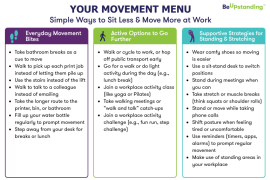With growing warnings that “sitting is the new smoking,” many workplaces have introduced standing desks, handed out pedometers, and organized “Health Challenge Months.” But here’s the real question: Are these efforts actually working?
A recent umbrella review published in The Lancet Public Health (Rouyard et al., 2025) offers a comprehensive look at how workplace interventions affect sedentary behaviour and physical activity. Drawing from 36 systematic reviews and 214 original studies, the findings are both eye-opening and instructive.
What is an Umbrella Review?
An umbrella review is a “review of reviews.” It summarises evidence from multiple systematic reviews on a broad topic to offer high-level insights. Think of it as a meta-summary—ideal for identifying trends, strengths, and gaps in a body of evidence.
The Challenge: We’re Still Sitting Too Much—And It’s Hard to Get Moving
Despite good intentions, global physical activity levels are stagnating or declining—especially in desk-based jobs. In fact, data shows that office workers spend about 72.5% of their workday sitting.
While standing desks can cut down sitting time by 67–75 minutes per day, they don’t significantly boost moderate-to-vigorous physical activity (MVPA)—the type that really benefits heart and metabolic health. So, in many cases, we’re just swapping “sitting still” for “standing still.”

What Actually Works? Here’s What the Research Found
To build a truly effective health strategy, the key is choosing the right intervention. The Lancet review breaks it down:
Best for Increasing Physical Activity: Pedometers + Psychological Incentives (e.g., goal setting, team challenges, reminders). This combination can increase daily steps by over 1,000—roughly 15 more minutes of walking. When combined with social or financial incentives (like points, prizes, or small bonuses), the impact is even stronger.
Best for Reducing Sitting Time: Standing desks remain the top tool. Combine them with prompts or behaviour commitments, and you could see reductions of up to 100 minutes of sitting per day.
Interventions with Limited or Uncertain Impact: Multi-level strategies (targeting individuals, organizations, and the environment) aren’t necessarily more effective. Almost no intervention consistently improves MVPA (e.g., brisk walking, cycling, or running).
Four Ingredients of an Effective Workplace Strategy
Start Small: “One More Step” Matters: Don’t aim for perfection—start with progress. Just 1,000 extra steps per day can reduce mortality risk by up to 15%.
Make It Easy: Automate Instead of Motivate: Use reminders, digital nudges, and walking meetings to make movement seamless—not another to-do item.
Create Social Momentum: Team-based approaches (leaderboards, group challenges) outperform individual programs. People stick to behaviour change better when they feel part of something.
Think Long-Term: Short campaigns are a good start, but sustainable results require systems for habit formation, feedback, and ongoing support.
What Are the Limitations in the Evidence?
Lack of diversity: Most studies were conducted in high-income countries with office-based populations. There’s little data on manual workers, shift workers, or low- and middle-income countries.
Short-term focus: Many interventions were short (under 3 months). Few long-term studies track whether behaviour changes stick.
Self-report bias: Nearly half of the outcomes were measured via self-report, which tends to overestimate physical activity.
COVID-19’s impact: The review acknowledges that pandemic-era changes in work (e.g. remote/hybrid work) are not yet fully reflected in the data. We still don’t know how these shifts have affected physical activity patterns at home.
Small sample size: Many of the studies included in the review had relatively small sample sizes, with findings not necessarily reflective of the broader workforce.
How Can the BeUpstanding Program Help?
The BeUpstanding™ program is well-positioned to address some of these challenges:
- It uses evidence-informed tools and resources to support workers in sitting less and moving more.
- It focuses on team-based, multi-level change, aligning with the strongest intervention types identified in the review.
- It’s flexible and scalable—applicable in both on-site and hybrid settings, which is essential in a post-COVID world.
- BeUpstanding collects data on real-world use, which contributes to the growing evidence base on what works across different industries and roles.
Final Thoughts
This Lancet review reminds us that not all “healthy-looking” initiatives are truly effective. To make real progress on employee wellbeing, we need to go beyond trendy tools and invest in strategies that drive real behaviour change.
This blog was written by Wenqi Yi as part of her 4th year psychological science placement with the BeUpstanding team.
![]()







